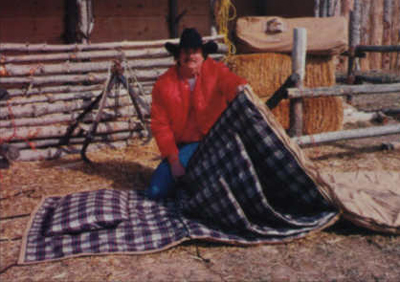
The Last Sleeping Bag
You'll Ever Need!

Eventually I graduated to one of the moderately priced G.I. down and feather mummy bags that became available at Army/Navy stores when the government made equipment changes. Sleeping encased in the fabric-wrapped down, although warm (often too warm), became a claustrophobic battle. Zipping up and down to regulate the temperature extremes, and rolling around much in the same manner one would if wrapped in the coils of a constricting snake, my night’s sleep was not much better than those spent freezing as a young kid.
Sometime later, along came the synthetic fabric offerings meant to "improve" our camping experience. Slick nylon-type materials allowed you the thrilling experience of sliding into a bag that felt much like a deep freeze until your body warmed IT up. And the translocation of your sleeping form from its original place, to the one in which you awoke, was much like a scene from Star Trek. If there was any slant at all where you placed your bag, you awoke in the morning feeling like a crumpled wad of trash — slid far into the corner of the tent.
However, the static-building properties of those bags were impressive. It didn’t take too many times of leaning over to plant a goodnight kiss on the wife, sending a two-inch blue spark to her lips, before you were greeted with a punch to the chest rather than a "Sleep tight, Honey" smooch! Thankfully, manufacturers saw the light after being named as material witnesses in all too many divorce cases, and most have returned once again to lining their bags with flannel.
There are some nice sleeping bags now on the market. Some are made for balmy spring evenings, and others are built to withstand a shift in the polar ice cap. I have a stack of them in my garage to prove it. But there wasn’t one bag that did it all — not until I found the bag that Jimmie Butler designed to be the best night's sleep on the market.
Butler’s search for a bag that provided the comfort and durability a real hunter needed was much as mine had been. We both had searched for a bag built big enough for a good-sized man to fit into comfortably, and one that could provide the needed level of warmth over a wide range of night temperatures. It must have the durability to stand up under punishing use during travel and at hunt camp.
He didn’t find it either! Not to be confounded by the situation, Butler sat down, incorporated his ideas of the perfect bag into a design, and began making the best bag on the market.
Butler Bags’ All Season Sleeping Bag is truly a bag for all seasons. Cut to a very generous 41" x 84", this sleeping bag allows room for even the largest man to turn over in without restriction. The outside cover is constructed of 12-oz. marine-grade cotton duck canvas, which is both water and mildew resistant. The heavy brass zipper is built to outlast the life of the hunter. The bag's filler is Holofil 808, and the lining is of comfortable polyester/cotton flannel.
Attention to detail is obvious when you notice that large flap/cover is lined with flannel for comfort should you desire to pull it over your head on those brutally cold nights. The Butler Bag also comes with a flannel-covered pillow, and a sewn-in pocket for your ground pad or air mattress. The All Season also features two nylon cinch straps, sewn in end ropes to ‘pucker’ the bag for packing, two heavy-duty carry handles, and a tote bag cut so generously that the ease of sliding the bag into it defies anyone to call it a "stuff sack." And this is just the chrome on this hot rod!
What makes this bag so unique and desirable are the three quilted compartments that allow you to choose the right amount of cover to comfortably sleep in temperatures ranging from +65 degrees, down to a frigid 20 below zero. I have found that up to around 70 degrees, the single top cover is still comfortable. And when using an additional Dream Sack silk bag inside, I can flip the top back and rest easily until the night chill hits, and also gain an extra minus 10 degrees at the other end of the scale.
This excellent sleeping bag tips the scale at 22 pounds, and is noticeably distinguished as a bag to be either driven to camp, or meant to be packed on horseback trips. But then if you can put up with a 20-mile hike back into the remote wilderness, I guess freezing your rump off in a 2-pound bag is of little concern for you anyway. Bluntly stated, this is a big bag that allows comfort far in excess of its size or cost.
If you do not sleep well, you cannot hunt well! Why would you ever compromise on something as vital as that?
You can see the entire Butler Bags product line at www.butlerbags.com or by contacting them at 1-800-922-BAGS.
THINK A GOOD THOUGHT!
Frank Medicine Wolf Springer
Copyright © 2002 J & D Outdoor Communications. All rights reserved.